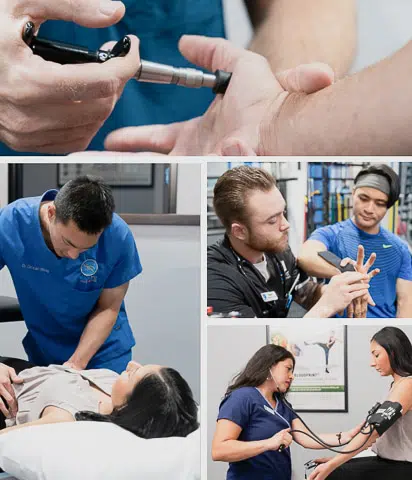Headaches + Migraines

Appointment Inquiries
Call us at: (877) 222-5348
Definition
Pain that occurs on one or both sides of the skull or face, may be isolated or radiate, and range from dull to throbbing to sharp.
Root Causes
Auras, Difficulty Falling Asleep, Difficulty Focusing, Dizziness, Fatigue, Irritability, Light Sensitivity, Loss of Appetite, Nausea, Noise Sensitivity, Puffy Eyes, Sweating, Tenderness
Risk Factors
Age, Alcohol Consumption, Bright Lights, Caffeine Consumption, Family History, Food Additives, Food Choice, Hormone Changes, Loud Noises, Medication, Missing Sleep, Physical Exertion, Sex, Skipping Meals, Strong Smells, Weather Changes
Treatments
Chiropractic, Diagnostic X-Ray, Lab Testing, Medical Intervention, MiRx Headache Protocol, Physical Therapy
What is a headache anyway?
While it may feel like it, a headache is not pain in the brain. The brain itself cannot feel pain as it has no pain nerves, but it can tell you where other parts of your body might hurt. Most head pain happens in the muscle and nerves in the head, neck, or face. Some headaches may also have a genetic factor.
Headaches or head pain is difficult to describe for many people, but common sensations include throbbing, squeezing, constant, and unrelenting. You may feel it in just one part of your face, on the front or side of your head, or it may feel as if it’s across the entire skull. It may come or go spontaneously or they may be regular for you. Severity may decrease or increase over time.
There are many types of headaches. The most common primary headaches (those without an underlying condition) are tension headaches, migraine headaches, migraines with auras, and tension headaches. Headaches may bring on nausea and vomiting, especially migraines. They can be triggered by external factors like exposure to intense light, sound, smells, or tastes.
Some headaches are symptoms of underlying diseases. These are called secondary headaches. They are much less common but can be much more severe. If you have a headache with a fever, weakness, change in feeling on one side of the body, or change in behavior, contact your primary care doctor or an emergency service immediately.
What are the symptoms of common headaches?
While diagnosis is required to confirm what type of headache you suffer from, the most common is a tension headache. Their cause is not well understood, but they are treatable. The most likely cause is severe tightening of the muscle that covers the skull. A tension headache feels like a tight band around the head or pain on both sides of the head. You may also feel pain or tension in the face and neck muscles, as well as difficulty falling asleep and sensitivity to light and loud noise.
Migraines with or without auras are the second most common form of headache. According to the American Migraine Foundation, migraines are the 3rd most common disease in the world, with 1 in 4 households in America with a member that suffers from chronic migraines. Migraines may last for hours, days, or weeks.
Retinal migraines, also known as ocular migraines or migraines with auras, are less common than migraines without auras. An aura is a visual disturbance in one or both eyes that can include flashes of bright light, shimmering spots or stars, blind spots, geometric designs, and floating zigzag lines. An aura usually precedes head pain by less than one hour and can be accompanied by tingling in the face or one hand and may travel up or down the arm. Concentration may become difficult, including speech and language difficulty.
Head pain from a migraine attack is often described as dull, acute, or throbbing pain. Migraine sufferers often report other symptoms including sensitivity to light, distorted vision, dizziness or lightheadedness, general malaise, sensitivity to light and/or sound, nausea, vomiting, irritability, nasal congestion, and scalp tenderness.
The third type of major headache is the cluster headache which occurs in patterns over time. Cluster headaches my last weeks or months, followed by a long period of remission for months or years. A cluster headache is severe and always on one side of the head. They are often accompanied by nasal discharge, red eye, or a tearing eye on the same side of the head. You may also experience drooping upper eyelid, small pupils, flushing, sweating, or agitation.
Headaches are one of the most common complaints for pain in the entire body. There are many other types of headaches that are treatable, such as sinus and allergy headaches, hormone/menstrual headaches, post-trauma headaches such as from concussion, and more. If you have moderate to severe head pain, especially if it’s regular, there are many treatment options and we can help.
How does BackFit treat headaches and migraines?
BackFit Health + Spine offers a number of progressive treatments for headaches and migraines. After evaluation of your symptoms, a family history, and a diagnosis (if you do not have one already), we will offer a treatment plan that may include one or more of the following to reduce or eliminate your headaches.
- Diagnostic Imaging: We may order x-rays in-house or ct scans to pinpoint areas to specifically target.
- Lab Testing: You may need a food allergy and environmental testing done to identify potential headache triggers.
- Chiropractic Care: By carefully and gently adjusting the joints in the back, neck, and skull, many patients’ headaches are relieved.
- Physical Therapy: Providing exercises to stretch the muscles in the neck and strengthen supporting muscles, such as those in the shoulders, can reduce head strain.
- Medical Care: While our goal is to provide a more natural solution, there are a number of temporary medical pain relief options available.
- MiRx® Protocol: This medical solution provides long-term relief to head pain through a nasal application procedure. While multiple sessions are normal, immediate relief is common.
Every patient experiences headaches differently. We will work with you regarding all aspects of your head pain so that we can provide you with a comprehensive, long-lasting solution. Our medical doctors, chiropractors, and physical therapists will all work together to provide pain relief and prevent your migraines and other headaches long term.
More About BackFit
Looking to learn more? Explore our locations, treatments, or our new patient offer below or contact one of the BackFit Family of staff to have your questions answered.


